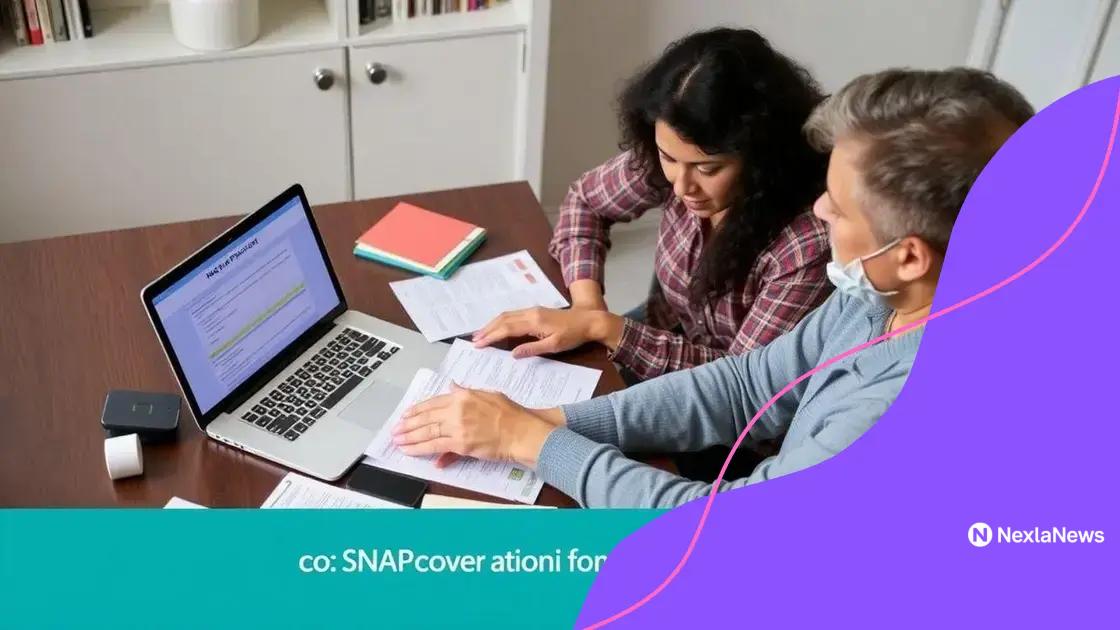SNAP Application: Unlocking Benefits for Your Future

The SNAP program provides vital nutritional assistance to low-income families, ensuring access to healthy food, reducing financial burdens, and improving overall health and well-being.
SNAP Application can be a game-changer for families looking for support. Have you ever wondered how it could help in tough times? Let’s dive into the details!
Understanding the SNAP program
The SNAP program, or Supplemental Nutrition Assistance Program, helps millions of Americans access food assistance. It’s essential for those facing food insecurity. Understanding how it works can open doors to vital support.
What is the SNAP program?
The SNAP program provides eligible low-income individuals and families with funds to buy food. These benefits are loaded onto an Electronic Benefits Transfer (EBT) card that works like a debit card. With SNAP, families can purchase nutritious food, ensuring they have access to a balanced diet.
Eligibility for SNAP
To qualify for SNAP, applicants must meet several criteria, including income thresholds. Households typically need to demonstrate a low income level, which varies by state. Other factors include household size and expenses, such as housing costs.
- Low-income requirements
- Residency criteria
- Household size considerations
- Asset limits
It’s important to note that some groups, like the elderly and disabled, may have different eligibility standards. Understanding these nuances is key to accessing benefits.
After applying, households will receive a notice detailing their eligibility and benefit amount. This process ensures that those who need the assistance most can access it.
How to Apply for SNAP
Applying for SNAP is relatively straightforward. Individuals can start the process online or in person at local welfare offices. The application requires information about income, expenses, and household members.
Once submitted, an interview may follow to verify information. This step is crucial to ensure that the right assistance reaches those who genuinely need it. It’s advisable to have required documents ready to streamline this process.
Understanding the SNAP program will empower you to make informed decisions regarding food assistance. This knowledge is vital for individuals and families facing tough economic challenges, providing them with hope and necessary support during difficult times.
Eligibility criteria for SNAP benefits
Understanding the eligibility criteria for SNAP benefits is essential for those seeking assistance. This program is designed to help families and individuals in need, but there are specific requirements to qualify.
Income Limits
The first factor in determining eligibility is the income level. Households must meet certain income limits that vary by state and household size. This ensures that assistance goes to those who need it most. Generally, a household’s gross income must not exceed 130% of the federal poverty level.
Household Composition
Another key aspect of eligibility is the composition of the household. Your household includes everyone who lives together and purchases food together. Even if you don’t buy or prepare meals together, if you live under one roof, you may be considered one household. Remember, the more people in your household, the higher your income limit will be.
- Count all family members living together
- Include children, parents, and other relatives
- Roommates may not be included
Special groups like the elderly, disabled, or homeless may have different criteria, making it important to check specific guidelines for these situations. For example, elderly individuals might not need to meet the same work requirements.
Assets and Resources
Asset limits are also an important factor. Households typically cannot have more than $2,750 in resources, or $4,250 if at least one member is elderly or disabled. Resources can include bank accounts, vehicles, and property. However, some resources, like your home or retirement accounts, are often excluded.
This balance is important for ensuring that SNAP benefits reach those who truly need support while still promoting self-sufficiency. Knowing the eligibility criteria can help ease the application process and connect families with the nutrition assistance they deserve.
Step-by-step guide to applying for SNAP

Applying for SNAP benefits can feel overwhelming, but following a simple step-by-step guide can make the process manageable. Knowing what to expect helps alleviate stress and set you on the path to receiving assistance.
Gather Necessary Documents
The first step is to gather the required documents. Having everything ready can speed up the application process. Documents you may need include proof of identity, income statements, and information about household expenses.
Complete Your Application
You can apply for SNAP online, by mail, or in person at your local SNAP office. For online applications, visit your state’s SNAP website. Fill out the application form thoroughly and accurately to avoid delays.
- Provide personal information
- List all household members
- Detail your income and expenses
- Sign and date the application
Once your application is submitted, it will be reviewed by a SNAP worker. You may receive a request for additional information, so be prepared to respond quickly.
Attend an Interview
After submitting your application, you’ll likely need to attend an interview. This can be done over the phone or in-person, depending on your state’s procedures. During the interview, a SNAP worker will verify the information you provided and may ask additional questions about your household and finances.
Be honest and thorough during this interview. This stage is crucial to determine your eligibility. Make sure to have any relevant documents and information at hand to facilitate the process.
Receive Your Eligibility Notice
After completing the interview, you will receive a notice regarding your eligibility. If approved, the notice will detail your benefits and when they will start. If denied, it will explain the reasons and how to appeal the decision.
Following this step-by-step guide will help ensure a smoother application process for SNAP benefits. With the right preparation and mindset, individuals and families can gain access to essential nutritional support.
Common misconceptions about SNAP
There are many common misconceptions about SNAP that can lead to confusion and misinformation. Understanding these myths is essential for anyone considering applying for benefits or seeking help.
Myth 1: SNAP is only for unemployed people
A widespread belief is that only unemployed individuals can qualify for SNAP. However, this is not true. Many working families, especially those with low incomes, rely on SNAP benefits to help put food on the table. It’s meant to assist those facing financial hardship, regardless of their employment status.
Myth 2: You can’t receive SNAP if you own a car or home
Some people think that owning a car or home disqualifies you from receiving SNAP. While there are asset limits, many homes and vehicles are exempt from consideration. For instance, your primary residence and one car for work are typically not counted as assets. Therefore, owning a car doesn’t automatically deny you assistance.
- Primary residence is usually exempt
- One vehicle may be excluded
- Some resources like retirement accounts might not count
Moreover, the rules may vary by state, so it’s critical to check local guidelines.
Myth 3: Applying for SNAP is too difficult
Many believe that applying for SNAP is complicated and time-consuming. While it does require some information and documentation, the process is designed to be accessible. With online applications and user-friendly resources, applicants can find the help they need. By gathering the required documents ahead of time, applicants can simplify the process significantly.
This misconception often discourages eligible individuals from applying. In reality, receiving food assistance can make a significant difference in financial stability and nutrition. Understanding the facts about SNAP can empower families to seek help without fear or misunderstanding.
Benefits of using SNAP for families
Utilizing the SNAP program can bring significant benefits to families in need. Understanding these advantages can help families make informed decisions about applying for assistance.
Nutritional Support
The primary benefit of SNAP is enhanced nutritional support. Families can use their benefits to purchase food items from authorized retailers. This access to nutritious food helps ensure that children and adults have a balanced diet.
Financial Relief
SNAP provides essential financial relief. For many families, food expenses are a major part of their budgets. With SNAP, families can redirect their funds to other necessary expenses, such as housing and healthcare.
- Less financial stress
- More disposable income for essential needs
- Reduces food insecurity
Many families find that this financial assistance makes a significant difference in their day-to-day lives, allowing them to focus on other areas of well-being.
Improved Overall Health
By helping families access nutritious food, SNAP can improve overall health outcomes. Healthier diets lead to better physical and mental health, reducing the risk of chronic diseases. Children who receive adequate nutrition tend to perform better in school, impacting their long-term success.
Moreover, when families are healthier, it can reduce medical costs, benefiting not just individuals but communities as a whole. Implementing SNAP fosters healthier lifestyles, which is critical in today’s society.
Ultimately, the benefits of using SNAP extend well beyond food assistance; they contribute to a family’s financial stability, health, and quality of life. Engaging with SNAP can empower families to thrive even during challenging times.
FAQ – Frequently Asked Questions about SNAP Benefits
What is the main purpose of the SNAP program?
The main purpose of the SNAP program is to provide nutritional assistance to low-income families, ensuring they have access to healthy food.
Do I need to be unemployed to qualify for SNAP benefits?
No, you do not need to be unemployed. Many working families can qualify for SNAP assistance based on their income.
How can SNAP benefits improve my family’s health?
By providing access to nutritious food, SNAP benefits help reduce food insecurity, leading to better health outcomes for family members.
What are the first steps in applying for SNAP?
The first steps include gathering necessary documents, completing an application, and scheduling an interview if required.
